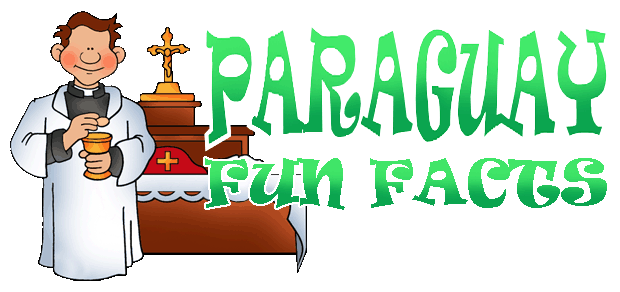Fun Facts about
Paraguay
Before the arrival of the Europeans,
Paraguay was inhabited by the Guaraní people. Guaraní and Spanish
are the two official languages of the country. And, the money of
Paraguay is also called the Guaraní.
The Spanish arrived in Paraguay in the early 1500's. Juan de Salazar, a Spanish explorer, founded the capital city Asunción in 1537. The full name of the capital city is actually Nuestra Senora de Santa Maria de Asunción.
Jesuit missionaries came to Paraguay in the 1600's. The Jesuits were very successful with the indigenous people. Their missions flourished until a royal decree ended the missions. Today, about 90% of the people in Paraguay are Roman Catholics.
Paraguay gained independence from Spain in 1811.
The flag of Paraguay has three horizontal stripes of red, white, and blue. However, in the center of the white stripe are different designs on the front and back of the flag. The country's coat of arms is on the front and the Treasury seal is on the back.
Bolivia and Paraguay are the only two landlocked countries in South America. However, the Paraguay River gives the country access to the Atlantic Ocean.
Iguazú Falls, on the border of Brazil and Argentina, used to belong to Paraguay. When Paraguay lost the War of the Triple Alliance in 1870 to Brazil, Uruguay, and Argentina, it lost 54,000 square miles of borderland. Some estimates claim that Paraguay lost 90% of its male population during that war.
The world's largest freshwater wetland is the Pantanal. It extends into Paraguay, Bolivia, and Brazil.
The climate of Paraguay ranges from temperate to tropical zones. The western part of the country has low marshy plains near the rivers and thorny scrub elsewhere. The eastern part of the country has grassy plains and wooded hills.
Paraguay leads the world in exporting hydroelectric power. The Itaipu Dam, which is shared with Brazil, is one of the world's largest dams.
Agriculture is a very important occupation in Paraguay. Cotton, sugarcane, soybeans, and corn are major crops. There are lots of pigs and cows. I was told that there are more cattle than people in Paraguay.
The most famous handicraft in Paraguay is a handwoven lace called Nandutí, which means "spider web" in Guaraní. Paraguayans are also known for their work with silver.
The Spanish arrived in Paraguay in the early 1500's. Juan de Salazar, a Spanish explorer, founded the capital city Asunción in 1537. The full name of the capital city is actually Nuestra Senora de Santa Maria de Asunción.
Jesuit missionaries came to Paraguay in the 1600's. The Jesuits were very successful with the indigenous people. Their missions flourished until a royal decree ended the missions. Today, about 90% of the people in Paraguay are Roman Catholics.
Paraguay gained independence from Spain in 1811.
The flag of Paraguay has three horizontal stripes of red, white, and blue. However, in the center of the white stripe are different designs on the front and back of the flag. The country's coat of arms is on the front and the Treasury seal is on the back.
Bolivia and Paraguay are the only two landlocked countries in South America. However, the Paraguay River gives the country access to the Atlantic Ocean.
Iguazú Falls, on the border of Brazil and Argentina, used to belong to Paraguay. When Paraguay lost the War of the Triple Alliance in 1870 to Brazil, Uruguay, and Argentina, it lost 54,000 square miles of borderland. Some estimates claim that Paraguay lost 90% of its male population during that war.
The world's largest freshwater wetland is the Pantanal. It extends into Paraguay, Bolivia, and Brazil.
The climate of Paraguay ranges from temperate to tropical zones. The western part of the country has low marshy plains near the rivers and thorny scrub elsewhere. The eastern part of the country has grassy plains and wooded hills.
Paraguay leads the world in exporting hydroelectric power. The Itaipu Dam, which is shared with Brazil, is one of the world's largest dams.
Agriculture is a very important occupation in Paraguay. Cotton, sugarcane, soybeans, and corn are major crops. There are lots of pigs and cows. I was told that there are more cattle than people in Paraguay.
The most famous handicraft in Paraguay is a handwoven lace called Nandutí, which means "spider web" in Guaraní. Paraguayans are also known for their work with silver.
